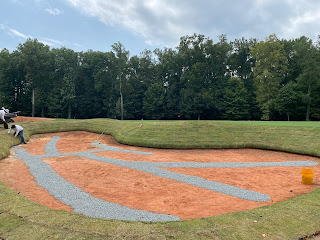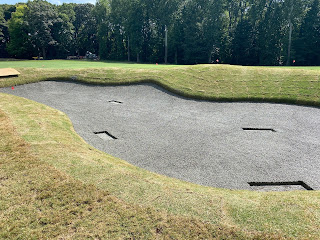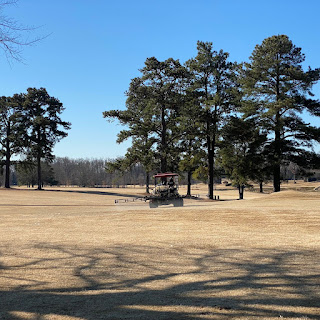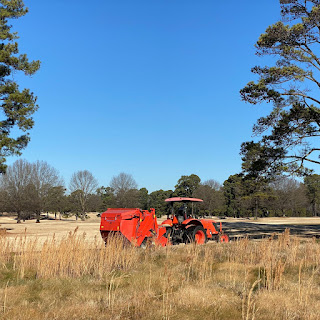Hello and welcome to The Greenkeeper! Today is Tuesday, February 1st and I want to take a moment and provide some information based on a question received during last week's Annual Meeting. It was a great question, and knowing not everyone was able to log in to the virtual meeting I figured this would be a great way to spread the word.
The question was about our bunker sand, and more specifically the asker wanted to know was the sand installed in the recently renovated bunkers different from the sand in the other bunkers on the golf course? Great question, and the answer is both No and Yes. How is that possible you ask, let me explain.
 |
| Ready for Liner |
 |
| Cap Con Liner |
 |
| New G-Angle Sand |
You may be surprised to learn the G-Angle sand from Golf Agronomics installed in the newly renovated bunkers last September is the same G-Angle sand installed in all the bunkers when we last renovated in 2013. Here is a link to a blog update from that project with some great photos detailing that work. http://carolinagreenkeeper.blogspot.com/2013/11/congrats-renovation-update-and-busy.html
So, we have established the new sand is the same sand, but it has been more than 8 years since that 2013 project. Yes, new sand is also added to the bunkers periodically, especially to those receiving the heaviest amount of play, but we are only talking about additions of an inch or so here and there.
The difference comes from contamination originating from the clay subsoil underneath. With the lack of a lining system in the older bunkers, that sand has been exposed to years of weather including silt and clay particles which are smaller altering the texture, making the sand heavier, percolate slower, and play differently.
The USGA says the useful life expectancy of bunker sand in Transition Zone climates is about 7 years, in bunkers without liners. Considering we recently endured three consecutive years (2018-2020) with extreme rainfall totals (58.50" average) it is easy to understand why our bunkers are in need of renovation, and in need of the liner. The new liner seals off the clay subsoil preserving and protecting the sand from contamination and prolonging its useful life.
So, the new sand is different because it is fresh and does not contain any of the silt, clay, and other contaminant particles that's in the older bunkers.
 |
| Note Color Difference |
I also mentioned last week how the new sand, although angular is not packed as tightly as the older sand containing smaller contaminant particles. We recently spent one of our Maintenance Mondays with two men dedicated to operating a vibratory plate tamp on all the newly renovated bunkers to help firm them up.
One other thing to note if you reviewed that 2013 post. The total number of bunkers on the property is now 81 with 79 on holes 1-18 and two practice bunkers. Two bunkers were added to the left side of Hole 7 in the fall of 2016. Click Here if you would like to revisit some photos from that project.
That's all for now. Hard to believe February is already here! Two months down and only one to go until Spring. You may find it hard to believe with three snow events last month and the cold temperatures we've experienced most of January this winter is still trending nearly 4 degrees above average thanks to the record warmth experienced in December. Guess those days with the AC on in December canceled out those bitterly cold, snowy mornings recently endured.
 |
| Courtesy Brad Panovich, WCNC |
See you on the course,
Matthew Wharton, CGCS, MG







